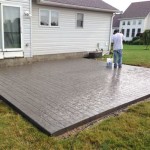Patio Heater Reviews: Heating Up Your Outdoor Space
As the seasons transition and the evenings grow cooler, maintaining a comfortable outdoor space can extend the enjoyment of patios, decks, and gardens. Patio heaters offer a solution for creating warmth and ambiance, allowing individuals to utilize these spaces for longer periods throughout the year. The market presents a diverse array of patio heaters, each with its own features, benefits, and drawbacks. This article provides an overview of different types of patio heaters, key considerations for selecting the appropriate heat source, and insights based on user experience and performance evaluations.
Patio heaters are broadly categorized by their fuel source: propane, natural gas, and electric. Each type offers distinct advantages and disadvantages in terms of heating output, operating costs, installation requirements, and environmental impact. Furthermore, the design and portability of patio heaters vary considerably, ranging from freestanding models to wall-mounted units and tabletop heaters.
Understanding Different Types of Patio Heaters
Propane Patio Heaters: Propane heaters are perhaps the most common type encountered, characterized by their mushroom-shaped design. These heaters utilize a standard propane tank, typically housed within the base of the unit, and offer a significant amount of heat output, often capable of warming a substantial area. Propane heaters are portable, allowing for flexible placement within the outdoor space. However, the need to refill propane tanks represents an ongoing cost and inconvenience. The safety aspects of propane heaters also warrant careful consideration, particularly regarding proper ventilation and storage of propane tanks.
Propane heaters typically range in heat output from 40,000 to 60,000 British Thermal Units (BTUs), making them suitable for larger patios or open spaces. The effective heating radius can extend from 10 to 20 feet, depending on the specific model and ambient weather conditions. The operational lifespan of a standard 20-pound propane tank typically ranges from 8 to 10 hours on the highest setting, influencing the overall operating cost. The environmental impact of propane heaters stems from the combustion of propane gas, which contributes to greenhouse gas emissions. However, compared to other fossil fuels, propane is considered a cleaner-burning alternative.
Natural Gas Patio Heaters: Natural gas heaters offer a more permanent heating solution, requiring a connection to a natural gas line. This eliminates the need for refueling and provides a continuous supply of fuel. Natural gas heaters are often preferred for commercial settings or residential spaces where a dedicated gas line is already in place. Installation can be more complex and expensive, requiring professional plumbing services. However, the long-term operating costs are typically lower compared to propane heaters, given the relatively lower cost of natural gas.
The heat output of natural gas heaters is comparable to that of propane heaters, typically ranging from 40,000 to 60,000 BTUs. However, the installation process necessitates adherence to local building codes and safety regulations. A licensed plumber or gas technician must install the gas line connection, ensuring proper sizing and leak testing. The environmental impact of natural gas is similar to that of propane, involving the emission of greenhouse gases during combustion. However, natural gas is often considered a more efficient and cleaner-burning fossil fuel than propane.
Electric Patio Heaters: Electric patio heaters represent a convenient and environmentally friendly heating option. These heaters plug into a standard electrical outlet and produce heat through infrared radiation. Electric heaters do not require fuel and produce no emissions, making them suitable for enclosed spaces or areas where air quality is a concern. Electric heaters are generally more compact and lightweight than propane or natural gas heaters, making them easy to move and store. However, the heat output of electric heaters is typically lower, making them more suitable for smaller spaces or targeted heating.
Electric patio heaters come in various form factors, including freestanding models, wall-mounted units, and tabletop heaters. The heat output typically ranges from 1,000 to 1,500 watts, which translates to approximately 3,400 to 5,100 BTUs. The effective heating radius is generally smaller than that of propane or natural gas heaters, often limited to a few feet. The operating cost of electric heaters depends on the electricity rate in the region. While electric heaters do not produce direct emissions, the indirect environmental impact depends on the source of electricity generation. If the electricity is generated from renewable sources, the environmental impact is minimal.
Key Considerations for Selecting a Patio Heater
Heating Needs and Space Size: The primary consideration in selecting a patio heater is the size of the area that needs to be heated. Larger spaces require higher heat output, typically provided by propane or natural gas heaters. Smaller spaces or targeted heating needs can be adequately addressed by electric heaters. Understanding the BTU rating or wattage of the heater is crucial in determining its heating capacity. It is advisable to overestimate the heating needs slightly to ensure adequate warmth, particularly during colder weather conditions.
Consider the layout of the outdoor space and the seating arrangement. If the desired area of warmth is concentrated in a single zone, a single high-output heater may suffice. However, if the seating is dispersed across a larger area, multiple heaters may be necessary to provide consistent warmth. For enclosed patios or covered areas, electric heaters are often preferred due to their lack of emissions. For open patios or decks, propane or natural gas heaters provide a more powerful heating solution.
Portability and Installation Requirements: The portability of the patio heater is an important factor, particularly for those who plan to move the heater frequently or store it during the off-season. Propane heaters are generally portable, but require the management of propane tanks. Electric heaters are also relatively portable, but require access to an electrical outlet. Natural gas heaters are typically stationary, requiring a permanent connection to a gas line. The installation requirements for each type of heater vary considerably.
Propane heaters require minimal installation, typically involving the attachment of the propane tank to the heater. Electric heaters simply plug into an electrical outlet. Natural gas heaters, on the other hand, require professional installation to ensure proper connection to the gas line and compliance with safety regulations. Consider the cost of installation when evaluating the overall cost of ownership. Wall-mounted heaters, regardless of fuel source, require professional installation to ensure secure mounting and proper electrical or gas connections.
Safety Features and Maintenance: Safety is paramount when operating any type of patio heater. All patio heaters should be equipped with safety features such as tip-over protection, which automatically shuts off the heater if it is accidentally tipped over. Propane and natural gas heaters should also have flame failure devices that cut off the gas supply if the flame is extinguished. Electric heaters should have overheat protection to prevent damage or fire hazards. Regular maintenance is essential for ensuring the safe and efficient operation of patio heaters.
Propane and natural gas heaters should be inspected regularly for gas leaks and burner obstructions. The burner should be cleaned periodically to remove debris and ensure proper combustion. Electric heaters should be inspected for frayed cords or damaged heating elements. The heater should be stored in a dry and protected location during the off-season to prevent corrosion or damage. Follow the manufacturer's instructions for proper maintenance and safety procedures.
User Experience and Performance Evaluations
Heating Effectiveness: User reviews consistently highlight the importance of heating effectiveness. Propane and natural gas heaters generally receive higher ratings for their ability to provide substantial warmth over a larger area. Electric heaters are often praised for their convenience and ease of use, but may be considered less effective in colder conditions or larger spaces. The effectiveness of a patio heater also depends on factors such as wind conditions and ambient temperature. In windy conditions, the heat can be quickly dissipated, reducing the effective heating radius. In colder temperatures, a higher BTU rating or wattage is necessary to maintain a comfortable temperature.
Ease of Use and Maintenance: Ease of use and maintenance are also important considerations for users. Electric heaters are often considered the easiest to use, requiring only a simple plug-in operation. Propane heaters require periodic refilling of propane tanks, which can be inconvenient for some users. Natural gas heaters require minimal maintenance, but may require professional servicing for gas line issues. The ease of cleaning and storing the heater is also a factor in user satisfaction. Heaters with removable parts or a compact design are generally easier to clean and store.
Durability and Longevity: The durability and longevity of a patio heater are significant factors in determining its overall value. Heaters constructed from high-quality materials, such as stainless steel or powder-coated aluminum, are generally more resistant to corrosion and wear. The heating elements or burners should also be of durable construction to withstand prolonged use. User reviews often mention the importance of purchasing a heater from a reputable brand with a solid warranty. A longer warranty period provides added assurance of the heater's quality and durability. Proper maintenance and storage can also significantly extend the life of a patio heater.
In summary, selecting the appropriate patio heater involves a careful assessment of heating needs, space size, portability requirements, safety features, and user preferences. Understanding the different types of patio heaters and their respective advantages and disadvantages is crucial in making an informed decision. User reviews and performance evaluations provide valuable insights into the real-world performance and reliability of different models. By considering these factors, individuals can select a patio heater that effectively heats their outdoor space and enhances their enjoyment of the outdoors.

The 2 Best Outdoor Patio Heaters Of 2024 Reviews By Wirecutter

The 2 Best Outdoor Patio Heaters Of 2024 Reviews By Wirecutter

10 Best Patio Heaters And Outdoor In 2024

The 2 Best Outdoor Patio Heaters Of 2024 Reviews By Wirecutter

10 Best Patio Heaters And Outdoor In 2024

10 Best Patio Heaters And Outdoor In 2024

Best Patio Heaters Of 2024 Cnet
:max_bytes(150000):strip_icc()/infrared-ca969264f834488aa54c2aee62d6c166.jpg?strip=all)
The 9 Best Patio Heaters Of 2024 For Year Long Entertaining Tested And Reviewed

Best Patio Heaters Of 2024 Cnet

10 Best Patio Heaters And Outdoor In 2024
Related Posts








